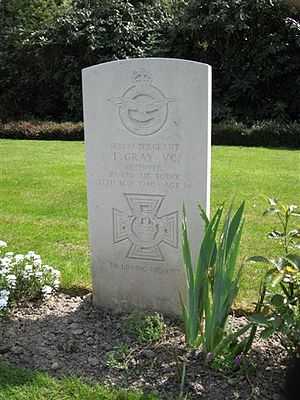Thomas Gray (VC)
| Thomas Gray VC | |
|---|---|
 | |
| Born |
17 May 1914 Urchfont, England |
| Died |
12 May 1940 (aged 25) Maastricht, Netherlands |
| Buried at | Heverlee War Cemetery, Belgium |
| Allegiance |
|
| Service/branch |
|
| Years of service | 1929 – 1940 † |
| Rank |
|
| Unit | No. 12 Squadron RAF |
| Battles/wars | Second World War |
| Awards |
|
Thomas Gray VC (17 May 1914 – 12 May 1940) was an English recipient of the Victoria Cross, the highest and most prestigious award for gallantry in the face of the enemy that can be awarded to British and Commonwealth forces.
He was 25 years old, and a sergeant in No. 12 Squadron RAF, Royal Air Force during the Second World War when the following deed took place for which he was awarded the VC.
On 12 May 1940, over the Albert Canal, Belgium, one bridge in particular was being used by the invading army, with protection from fighter aircraft, anti-aircraft and machine-guns. The RAF was ordered to demolish this vital bridge, and five Fairey Battle bombers were despatched with Sergeant Gray as the navigator in the plane leading the bombing attack. They met an inferno of anti-aircraft fire, but the mission was accomplished, much of the success being due to the coolness and resource of the pilot (Donald Edward Garland) of the leading aircraft and the navigation of Sergeant Gray. Unfortunately the leading aircraft and three others did not return.
Gray is buried at the Heverlee War Cemetery near Leuven in Belgium.[1]
Victoria Cross citation
The announcement and accompanying citation for the decoration was published in supplement to the London Gazette on 11 June 1940, reading[2]

Air Office, 11th June, 1940The KING has been graciously pleased to confer the VICTORIA CROSS on the undermentioned officer and non-commissioned officer in recognition of most conspicuous bravery :-
Flying Officer Donald Edward Garland (40105)
563627 Sergeant Thomas Gray
Flying Officer Garland was the pilot and Sergeant Gray was the observer of the leading aircraft of a formation of five aircraft that attacked a bridge over the Albert Canal which had not been destroyed and was allowing the enemy to advance into Belgium. All the aircrews of the squadron concerned volunteered for the operation, and, after five crews had been selected by drawing lots, the attack was delivered at low altitude against this vital target. Orders were issued that this bridge was to be destroyed at all costs. As had been expected, exceptionally intense machine-gun and anti-aircraft fire were encountered. Moreover, the bridge area was heavily protected by enemy fighters. In spite of this, the formation successfully delivered a dive-bombing attack from the lowest practicable altitude. British fighters in the vicinity reported that the target was obscured by the bombs bursting on it and near it. Only one of the five aircraft concerned returned from this mission. The pilot of this aircraft reports that besides being subjected to extremely heavy anti-aircraft fire, through which they dived to attack the objective, our aircraft were also attacked by a large number of enemy fighters after they had released their bombs on the target. Much of the success of this vital operation must be attributed to the formation leader, Flying Officer Garland, and to the coolness and resource of Sergeant Gray, who in most difficult conditions navigated Flying Officer Garland's aircraft in such a manner that the whole formation was able successfully to attack the target in spite of subsequent heavy losses. Flying Officer Garland and Sergeant Gray did not return.
Memorial
A Vickers VC-10 Serial 'XR807' of 101 Squadron is named 'Donald Garland VC & Thomas Gray VC'
References
- British VCs of World War 2 (John Laffin, 1997)
- Monuments to Courage (David Harvey, 1999)
- The Register of the Victoria Cross (This England, 1997)
External links
- Flying Officer D.E. Garland & Sergeant T. Grey in The Art of War exhibition at the UK National Archives
- Find-A-Grave profile for Thomas Gray